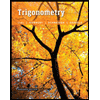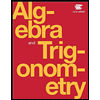**Text:** The function graphed is of the form \( y = a \sec(bx) \) or \( y = a \csc(bx) \), where \( b > 0 \). Determine the equation of the graph. **Graph Explanation:** The graph shows two segments of an upward-opening curve and one downward-opening curve, consistent with the behavior of a secant function. These curves intersect the \( y \)-axis and have vertical asymptotes where the function is undefined. - The \( x \)-axis is labeled with key points at \(-\frac{\pi}{2}\), \(-\frac{\pi}{4}\), \(0\), \(\frac{\pi}{4}\), and \(\frac{\pi}{2}\). - The \( y \)-axis is labeled with integers from \(-6\) to \(6\), indicating the range on the graph. - Vertical asymptotes are visible at \( x = -\frac{\pi}{2} \), \( x = 0 \), and \( x = \frac{\pi}{2} \). - The curves pass through \( (0, 1) \) and appear symmetric about the \( y \)-axis, which suggests the usage of a secant function. Given these observations, \( b \) in the functions \( \sec(bx) \) or \( \csc(bx) \) would be calculated to match the period \(-\frac{\pi}{2}\) to \(\frac{\pi}{2}\), implying a full period of \(\pi\). Hence, \( b = 2 \), and the equation is likely \( y = \sec(2x) \). The image shows a graph with both x and y axes. The graph depicts a periodic function, likely the cosine function. **Axes Description:** - The x-axis is labeled "x" with tick marks at \(-\frac{\pi}{2}\), \(-\frac{\pi}{4}\), \(0\), \(\frac{\pi}{4}\), and \(\frac{\pi}{2}\). - The y-axis is labeled "y" with tick marks at intervals of 2, ranging from -6 to 6. **Function Description:** - The function appears to have the shape of an inverted cosine curve. There are two full cycles shown between \(-\frac{\pi}{2}\) and \(\frac{\pi}{2}\). - The maximum points of the curves appear at the y-values of 6, while the minima hit -6. This graph is likely used to illustrate the periodic nature and properties of cosine or a similar trigonometric function, such as plotting transformations or examining amplitude and frequency changes.
**Text:** The function graphed is of the form \( y = a \sec(bx) \) or \( y = a \csc(bx) \), where \( b > 0 \). Determine the equation of the graph. **Graph Explanation:** The graph shows two segments of an upward-opening curve and one downward-opening curve, consistent with the behavior of a secant function. These curves intersect the \( y \)-axis and have vertical asymptotes where the function is undefined. - The \( x \)-axis is labeled with key points at \(-\frac{\pi}{2}\), \(-\frac{\pi}{4}\), \(0\), \(\frac{\pi}{4}\), and \(\frac{\pi}{2}\). - The \( y \)-axis is labeled with integers from \(-6\) to \(6\), indicating the range on the graph. - Vertical asymptotes are visible at \( x = -\frac{\pi}{2} \), \( x = 0 \), and \( x = \frac{\pi}{2} \). - The curves pass through \( (0, 1) \) and appear symmetric about the \( y \)-axis, which suggests the usage of a secant function. Given these observations, \( b \) in the functions \( \sec(bx) \) or \( \csc(bx) \) would be calculated to match the period \(-\frac{\pi}{2}\) to \(\frac{\pi}{2}\), implying a full period of \(\pi\). Hence, \( b = 2 \), and the equation is likely \( y = \sec(2x) \). The image shows a graph with both x and y axes. The graph depicts a periodic function, likely the cosine function. **Axes Description:** - The x-axis is labeled "x" with tick marks at \(-\frac{\pi}{2}\), \(-\frac{\pi}{4}\), \(0\), \(\frac{\pi}{4}\), and \(\frac{\pi}{2}\). - The y-axis is labeled "y" with tick marks at intervals of 2, ranging from -6 to 6. **Function Description:** - The function appears to have the shape of an inverted cosine curve. There are two full cycles shown between \(-\frac{\pi}{2}\) and \(\frac{\pi}{2}\). - The maximum points of the curves appear at the y-values of 6, while the minima hit -6. This graph is likely used to illustrate the periodic nature and properties of cosine or a similar trigonometric function, such as plotting transformations or examining amplitude and frequency changes.
Trigonometry (11th Edition)
11th Edition
ISBN:9780134217437
Author:Margaret L. Lial, John Hornsby, David I. Schneider, Callie Daniels
Publisher:Margaret L. Lial, John Hornsby, David I. Schneider, Callie Daniels
Chapter1: Trigonometric Functions
Section: Chapter Questions
Problem 1RE:
1. Give the measures of the complement and the supplement of an angle measuring 35°.
Related questions
Question

Transcribed Image Text:**Text:**
The function graphed is of the form \( y = a \sec(bx) \) or \( y = a \csc(bx) \), where \( b > 0 \).
Determine the equation of the graph.
**Graph Explanation:**
The graph shows two segments of an upward-opening curve and one downward-opening curve, consistent with the behavior of a secant function. These curves intersect the \( y \)-axis and have vertical asymptotes where the function is undefined.
- The \( x \)-axis is labeled with key points at \(-\frac{\pi}{2}\), \(-\frac{\pi}{4}\), \(0\), \(\frac{\pi}{4}\), and \(\frac{\pi}{2}\).
- The \( y \)-axis is labeled with integers from \(-6\) to \(6\), indicating the range on the graph.
- Vertical asymptotes are visible at \( x = -\frac{\pi}{2} \), \( x = 0 \), and \( x = \frac{\pi}{2} \).
- The curves pass through \( (0, 1) \) and appear symmetric about the \( y \)-axis, which suggests the usage of a secant function.
Given these observations, \( b \) in the functions \( \sec(bx) \) or \( \csc(bx) \) would be calculated to match the period \(-\frac{\pi}{2}\) to \(\frac{\pi}{2}\), implying a full period of \(\pi\). Hence, \( b = 2 \), and the equation is likely \( y = \sec(2x) \).

Transcribed Image Text:The image shows a graph with both x and y axes. The graph depicts a periodic function, likely the cosine function.
**Axes Description:**
- The x-axis is labeled "x" with tick marks at \(-\frac{\pi}{2}\), \(-\frac{\pi}{4}\), \(0\), \(\frac{\pi}{4}\), and \(\frac{\pi}{2}\).
- The y-axis is labeled "y" with tick marks at intervals of 2, ranging from -6 to 6.
**Function Description:**
- The function appears to have the shape of an inverted cosine curve. There are two full cycles shown between \(-\frac{\pi}{2}\) and \(\frac{\pi}{2}\).
- The maximum points of the curves appear at the y-values of 6, while the minima hit -6.
This graph is likely used to illustrate the periodic nature and properties of cosine or a similar trigonometric function, such as plotting transformations or examining amplitude and frequency changes.
Expert Solution
This question has been solved!
Explore an expertly crafted, step-by-step solution for a thorough understanding of key concepts.
This is a popular solution!
Trending now
This is a popular solution!
Step by step
Solved in 5 steps with 4 images

Recommended textbooks for you

Trigonometry (11th Edition)
Trigonometry
ISBN:
9780134217437
Author:
Margaret L. Lial, John Hornsby, David I. Schneider, Callie Daniels
Publisher:
PEARSON

Trigonometry (MindTap Course List)
Trigonometry
ISBN:
9781305652224
Author:
Charles P. McKeague, Mark D. Turner
Publisher:
Cengage Learning


Trigonometry (11th Edition)
Trigonometry
ISBN:
9780134217437
Author:
Margaret L. Lial, John Hornsby, David I. Schneider, Callie Daniels
Publisher:
PEARSON

Trigonometry (MindTap Course List)
Trigonometry
ISBN:
9781305652224
Author:
Charles P. McKeague, Mark D. Turner
Publisher:
Cengage Learning


Trigonometry (MindTap Course List)
Trigonometry
ISBN:
9781337278461
Author:
Ron Larson
Publisher:
Cengage Learning